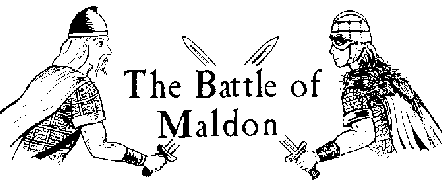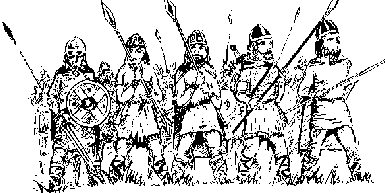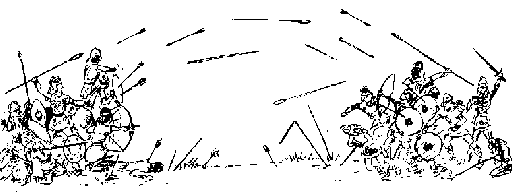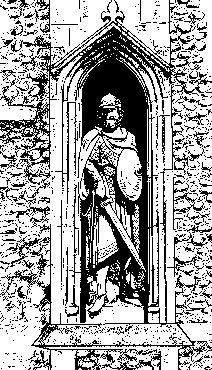Maeldune - Light on Maldon's Distant Past

Derek Punchard
THE tale of the battle between Viking and Anglo-Saxon forces at Maldon has often been told. In the early days of August, a thousand years ago, the people of Maldon and its surrounding district must have heard with foreboding the news of the Vikings ravaging the coastal towns of the South East. Perhaps they drew comfort from the thought that the venerable earldorman of Essex, Byrhtnoth, had quickly gathered together the East Saxon levies and was preparing to defend their homeland.
It was not long before the menacing sight of a large Viking fleet appeared in the Blackwater estuary, commanded by Olaf Tryggvason, already famed for his military exploits and soon to take the throne of Norway. The ships beached on the far side of Northey island which offered a safe anchorage and a means of rapid retreat.
The news of the Viking arrival spurred the waiting Byrhtnoth into action. Not the man to shirk a challenge, he wasted no time sheltering behind the defences of the burh. He marched his men rapidly towards Northey Island to confront the foe. There could be no immediate battle. The tide was high and swirled across the causeway that linked the island to the mainland. Byrhtnoth drew up his men in battle order, giving them advice and encouragement and then took his place amongst his household warriors. A Viking spokesman shouted across the waters, offering peace in return for gold. Byrhtnoth's voice rang out, promising not gold but spears. Some men were struck down by arrows as the two sides stood facing each other, tense and expectant, waiting for the tide to ebb. When it did so sufficiently for the first Viking to attempt to cross the causeway, he was struck down and killed by Wulfstan who, with two other warriors, barred the way. Thwarted by the Saxon determination to defend the causeway, the Vikings began to plead to be allowed to cross in order to give battle.
Byrhtnoth, confident that he could deal the Vikings such a blow that they would flee the land, cleared the causeway for them to cross. The savage foe waded across and formed themselves up in battle array.

|
The Viking Wihada (War Hedge) |
Byrhtnoth rode back and forth along the lines of his men exhorting them to stand firm before the coming onslaught. As dark shadows of circling ravens passed back and forth a momentary hush fell on the battlefield. Then came the swish of swift sharp spears seeking the mortal flesh of adversaries.

|
The Beadscur (Battle Shower) |
As blood began to flow the Viking with swords unsheathed rushed forward to clash with Byrhtnoth's valient men in fierce and bloody conflict.
Wulfmaer, Byrhtnoth's nephew fell early in the battle but, for a time, the Saxons more than held their own. Byrhtnoth was clearly the object of the Viking's fury and after suffering several wounds, his sword fell from his hand and he sank into the arms of two warriors. As he lifted up his eyes and his voice, commending his soul to the mercy of God, he was finally slain. The turning point of the battle had come. Godric, to whom Byrhtnoth had shown favour, seized his lord's horse and fled the battlefield. He was followed by others who chose dishonour rather than loyalty to their fallen leader. Some, however, were determined to fight on to avenge their dead lord. Invoking the name of Byrhtnoth and their unshakeable allegiance they took up the fight with renewed vigour. One by one, however, they fell until, defiant to the last, they yielded victory to the Viking foe.
The triumphant enemy hewed off the head of Byrhtnoth and departed from the corpse strewn battlefield. Later, monks from Ely took the body of Byrhtnoth and buried it in their great cathedral.
Such is the tale woven out of a few fragmentary records and a celebrated Saxon poem on the subject. Much has been written, but little is known for certain, about the battle.
The only contemporary or near contemporary sources for the battle are the Anglo-Saxon Chronicle, the 'Life of Oswald' and, of course, the poem on the battle. The seven separate chronicles which make up the Anglo-Saxon Chronicle provide two versions of the event.
991 - In this year Ipswich was harried and very soon afterwards Earldorman Byrhtnoth was slain at Maldon, and in the same year it was decided for the first time to pay tribute to the Danes on account of the atrocities they wrought along the sea coast. On this first occasion it amounted to ten thousand pounds. This course was adopted on the advice of the archbishop Sigeric.
993 - In this year came Anlaf with ninety three ships to Folkestone, and harried outside, and thence to Ipswich, overrunning all the countryside, and so on to Maldon. Earldorman Byrhtnoth came to meet them with his levies and fought them, but they slew the Earldorman there (10 August) and had possession of the place of slaughter. Afterwards peace was made with them and the king stood sponsor for him (Anlaf) at confirmation; this was done on the advice of Sigeric, archbishop of Canterbury andAelhsah, bishop of Winchester.
The second version has given rise to the belief that the Viking forces at the battle were led by Olaf Tryggvason, named as Anlaf in the Chronicle. Olaf's exploits as a famous Scandinavian warrior and King of Norway were celebrated much later in Norwegian literature, notably in 'The Saga of King Olaf Tryggvason' by Snorri Sturlson. This saga relates Olaf's plundering progress around the shores of England, Scotland and Wales but only in very brief and general terms. Nowhere is Maldon mentioned nor can it be expected that such a saga should provide accurate details, let alone a precise date. Scholars have long considered that the chronicler of this version combined events from the years 991 to 994 under the year 993. There has been less agreement over whether the chronicler has similarly wrenched Olaf out of the context of 994 to put him into the events of 991. Evidence that this was so can be found in other versions of the chronicles which, under the year 994, record in some detail an attack by Olaf on London with a fleet of 94 ships and a subsequent agreement in which Olaf promised not to return to England again. The undated text of a treaty between King Athelred and Olaf survives and would appear to be the agreement recorded in these chronicles under the year 994. Olaf's presence at the battle cannot be ruled out and most scholars remain open minded on the subject. Swein has also been suggested as a leader in the confident knowledge that, although it cannot be proved, it cannot be disproved either.
Olaf is certainly absent from the 'Vita Oswaldi' or 'life of Oswald' written in the late tenth or early 11th century by Byrthferth, a monk at the monastery of Ramsey. This account does not, however, shed much light on the battle. It contains certain physical details about Byrhtnoth such as his size and his age, stating that 'he, himself, stood tall in stature, towering above the others' and referring to the 'white hairs of his head' and 'the infirmity of his body'. There is also the comment that the Danes were so badly mauled that 'they had scarcely enough men to man their ships'. In other respects the source has little value and contains obvious inaccuracies such as stating that the battle took place in 988. The author was concerned more to eulogise the memory of Byrhtnoth than to provide an accurate historical record. This was to be expected since Byrhtnoth was known and respected at Ramsey.
Later Latin accounts furnish a few more details. The 'Florentii Wigorniensis Monarchi' or 'The Chronicle of Chronicles', traditionally attributed to Florence of Worcester but now assigned, by scholars, to John of Worcester, was written in the twelfth century and contains two new pieces of information. It gives the names of the Vikings leaders as Justin and Guthmund, and states that Byrhtnoth was ealdorman of Essex. It is not known for certain where John obtained his information from but it is thought that it might have been from a chronicle no longer in existence. It has been argued that John took the names of Justin and Guthmund from the text of the undated (994) treaty with the Danes although, if this was so, it would have seemed logical for John to have included Olaf also. Two further accounts, by Simeon of Durham and Henry of Huntingdon respectively, are short and add nothing to our knowledge.
By far the fullest account appears in the Liber Eliensis (The Ely Book). It, too, identifies Justin and Guthmund as the leaders of the Vikings. It is also the source of the notion that in 987 there was a previous battle against the Vikings at Maldon in which Byrhtnoth 'met them with an armed force and killed nearly all of them on the bridge'. Their appearance in 991 was inspired, it is said, largely by a desire to avenge this defeat. Indeed, according to the Liber Eliensis, the Vikings sent a personal message to Byrhtnoth that if he did not come to fight them they would consider him a coward. Naturally enough, Byrhtnoth rose to the challenge, marched south and fought them for a fortnight before being killed and decapitated. The last section of the account deals with the removal of Byrhtnoth's body from the battlefield and its burial with a ball of wax in place of the absent head in Ely cathedral.
The accuracy of the Liber Eliensis has been generally questioned. There is no corroboration of a previous battle and one of fourteen days is clearly far fetched. A long section preceding the account of the battles with the Vikings is dedicated to fulsome praise of Byrhtnoth's virtues, which was perhaps understandable as Byrhtnoth had been a generous benefactor to the monastery. There seems, however, little reason to doubt the account of Byrhtnoth's burial. His widow, Aelfflead, records the burial in her will and the monk who wrote the account witnessed the reburial of Byrhtnoth's remains in another part of the cathedral.
An 18th century antiquarian, James Bentham, examined the remains during rebuilding and noted the absence of the head and the fact that the collar bone 'appeared to have been cut through with, perhaps, a battle-axe or a two handed sword'. A Dr. Hunter, examined the bones and concluded that Byrhtnoth was 6' 9" tall which seems to confirm the description contained in the 'Vita Oswaldi'. However, Dr. Hunter's calculation that six bishops interred with Byrhtnoth were all over 6 feet tall rather casts doubt on his methods. The author of Liber Eliensis may well have got some of his information from a tapestry commissioned by Byrhtnoth's widow to commemorate his life. This, alas, has long been lost.
The battle at Maldon in 991 would have received little attention had it not been the inspiration for the celebrated poem on the subject. The poem as a work of fiction has received a great deal of attention from scholars of Anglo-Saxon literature.
Although an indispensable source for historians, it has to be approached with caution for it is first and foremost a work of literature and not of history. How much genuine history it contains will, perhaps, never be known. Its main purpose was not to provide accurate historical information but to use an important historical event as a basis for a statement about the nature of loyalty and the relationship between a lord and his retainers. The problem is to decide how far the historical basis determined the content of the poem and how far the content of the poem determined the details of the battle.
The historical existence of some of the participants named in the poem has been supported by evidence elsewhere and the poet's acquaintance with them suggests an early date for the composition. Furthermore, it has been shown that the spelling of Byrhtnoth's name underwent a permanent change quite early in the 11th century and that the poem uses the original form. The likelihood, therefore, that the poem was composed shortly after the battle enhances its value as an historical source. It is certainly true that the many stylised speeches are clearly fictional and the author makes the action point the moral. Most scholars would, however, reject the extreme scepticism of suggesting that the poet might have visited the area and decided on the location of river and causeway upon which to base his epic poem. It seems reasonable to accept the general accuracy of the poet's account of the defence of the ford or causeway and Byrhtnoth's decision to allow the Vikings across. It is also entirely plausible that the Vikings would chose an island as a base for an attack on Maldon.
Much has been written about the battle tactics of Byrhtnoth. In particular, his decision to allow the Vikings to cross the causeway onto the mainland has been exhaustively discussed both from the literary point of view as to the exact meaning of the poet's words in relation to that decision and also whether it could be be justified on military grounds. The words the poet uses to comment on Byrhtnoth's decision have been variously interpreted as meaning 'overconfidence', 'arrogance', 'excessive pride' and 'courageous'. Commentators have generally preferred the critical interpretation. The poet, like the historian, had the benefit of hindsight. Byrhtnoth clearly made the wrong decision for the wrong reason because he lost. However, a good case can be made for Byrhtnoth. Although it appears that the Vikings could have been prevented from landing by continued defence of the causeway, Byrhtnoth would, one assumes have been well aware that they would have sailed away to devastate other regions.
A decisive defeat of the enemy was only possible there and then if the Vikings could be brought to battle. Such a victory might have altered the course of the war by reversing the series of defeats suffered by the Saxons. Ultimately, Byrhtnoth's action can only be sensibly judged on the basis of military calculation as to whether or not his forces were likely to defeat the Vikings. Byrhtnoth was a seasoned soldier and presumably not likely to lose his military head in an unnecessary gesture of heroism.
As with most controversies where speculation rather than information predominates, no definite conclusion is ever likely to be reached.
The location of the site of the battle has inevitably evoked a great deal of controversy and speculation. This issue has been discussed at length elsewhere in the book.
It has to be said that, realistically, there is little chance of discovering any further evidence which will clarify the events that made Maldon, briefly, a place of national importance. However, it is one of the fascinations of history that certainties are always in danger of being overthrown. It is not surprising that, with most other aspects of the battle the subject of largely unresolved dispute, its significance should also cause controversy.
Some commentators have regarded it as but one in a long line of defeats and, therefore, of little importance. Others disagree and consider that the defeat of the foremost military leader seemed to suggest that all was lost and that the decision to pay danegeld was the logical outcome of the general mood of despair. However, this was not the first time that danegeld had been paid. Alfred had adopted the same policy. Also it was not the end of resistance. In 994 the Danish attack on London was bloodily repulsed and, although more money was paid over, Olaf agreed to leave the shores of England for good. In retrospect the defeat in 991 does appear a turning point. No-one seemed capable of co-ordinating resistance against a formidable foe. Aethelred lacked the character and ability of his illustrious forebears to do so. Consequently, there was to be no relief from the Danish assault. Further devastating raids by Swein led to the payment of more danegeld, culminating in the huge sum of ?48,000 in 1010. Such a sum was certainly evidence of the wealth of England and its attraction to the Vikings. It also suggests that, despite Aethelred's reputation, England continued to be effectively administered.
Only the brief but heroic reign of Aethelred's son, Edmund, known as 'Ironside' offered a check to the triumphant progress of the Danes. Edmund, however, suffered a devastating defeat by Cnut at Assundun in 1016. As with the battle of Maldon, the site of Assundun has aroused much controversy with Ashingdon, south of the Crouch and Ashdon, near Saffron Walden having their respective supporters although the latest research offers a plausible case against Ashingdon.
By 1016, Swein's son, Cnut, had become undisputed king in England. In 1042, however, the Danish royal line came to an end and the throne reverted once more to the Saxon line in the person of Edward the Confessor.
BYRHTNOTH, EARLDORMAN OF ESSEX
Byrhtnoth must be one of the few military commanders whose fame rests on defeat rather than victory. Without that defeat he would have remained an obscure footnote to the history of the period.
It is probable that he was born about the year 930. To suggest a much earlier date would make his age at the battle impossibly old. To make it later would have made him somewhat too young for marriage with Aefflaed, a daughter of Aelfgar, ealdorman of Essex. Aelfgar, in his will, which was almost certainly drawn up before he ceased to be earldorman in 950 or 951, refers to Byrhtnoth as his son-in-law. Aelfgar's other daughter, Aethelflaed, was married to King Edmund and so it is clear that Byrhtnoth must have been a man of some standing, even, perhaps, claiming descent from the Mercian royal house.

|
Although his land holdings were mainly concentrated in East Anglia, particularly Cambridgeshire, Suffolk and Essex, he had others as far afield as Worcestershire and Gloucestershire. Both Aelfgar and Aethelflaed bequeathed substantial lands to him, many of them in Essex, including estates at Woodham, Totham, Fingringhoe, Mersea, Peldon and Greenstead. He would, consequently, have been particularly keen to defeat the Viking attack on Maldon. Byrhtnoth made generous grants to religious institutions, notably to the abbey at Ely. It is, therefore, not surprising that monkish writings sang his praises so highly, stressing not only his piety but his courage, skill, wisdom, eloquence, generosity, loyalty, his consideration for others and his patriotism as a fierce defender of his country's liberty. Whether he was quite such a paragon remains open to doubt but that he was a powerful and respected figure is certain. |
His religious concerns involved him in the violent struggle between those who espoused the reform of the church by a vigorous support of the monastic ideal and those who resented the power and wealth of the monks. Byrhtnoth offered firm support to King Edgar's efforts to reform the church and when Edgar died, Byrhtnoth opposed Aeflhere of Mercia's attack on monkish power. The Liber Eliensis tells of Byrhtnoth's opposition to the greed of those who would refill the monasteries with men who had rightly been expelled during the reign of Edgar.
He became earldorman of Essex, probably in the year 956 because it was in this year he first signed documents in that position. Byrhtnoth would have been involved in the turbulent reign of King Eadwig from 955 to 959. During the reign of King Edgar, Byrhtnoth seems to have been the third most important earldorman, signing documents after Aelfhere of Mercia and Aethelwine of East Anglia. In 983 Aelfhere died and in 991 Aethelwine fell ill and thus Byrhtnoth became the senior active earldorman of England and, as such, the military commander of King Aethelred's forces.
The defeat and death of Byrhtnoth at the Battle of Maldon must have been, not only a severe military setback, but a psychological one as well. It might well have seemed that danegeld was the only alternative.
| Mealdune Contents | Maldon Archaeological Reports Home | Next section..... |